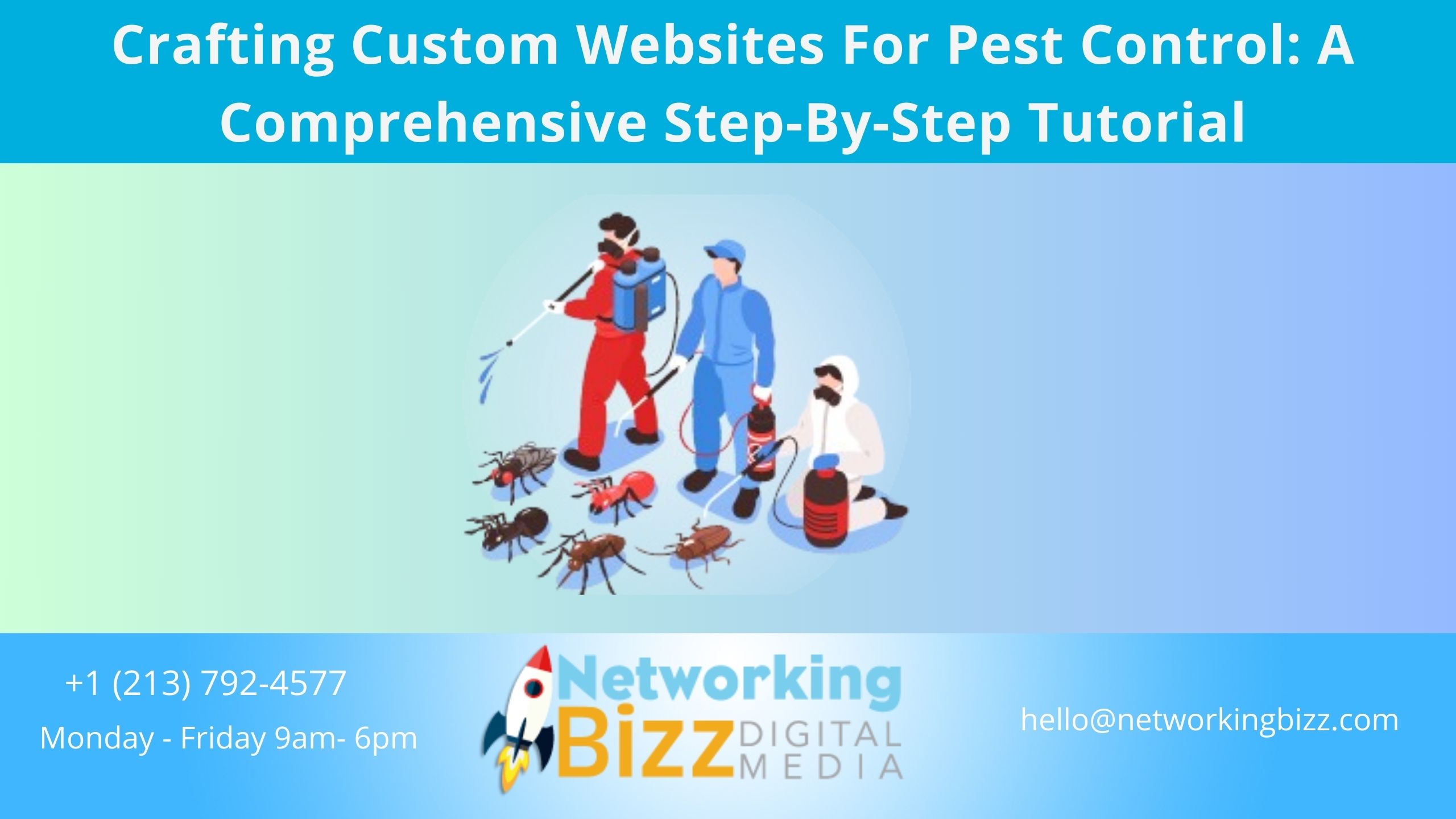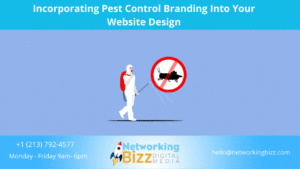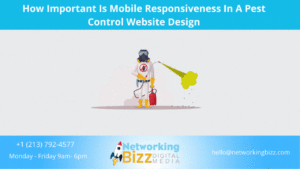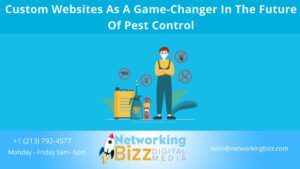Introduction
It is crucial for every company, including pest control companies, to have a robust web presence in this day and age (the digital era). In addition to operating as a digital storefront, a custom website design pest control that has been carefully built may also assist in the development of credibility, the acquisition of new clients, and the efficient presentation of services. We will walk you through the process of creating a bespoke website that is geared exclusively for businesses that serve the pest treatment industry in this in-depth lesson that is broken down into simple steps. A prominent web design and digital marketing organization that is committed to assisting businesses in achieving success online, Networking Bizz, is the company that is providing this tutorial.
Understanding The Importance Of A Custom Website
Before diving into the technical aspects of website creation, it’s crucial to understand why having a custom website is essential for pest control companies. Here are some reasons:
Brand Identity: A custom website allows you to showcase your brand identity effectively, including your company logo, colors, and messaging, which helps in creating a memorable impression on visitors.
Targeted Messaging: With a custom website, you can tailor your messaging to address the specific needs and pain points of your target audience, such as pest control solutions for residential or commercial properties.
Enhanced Functionality: Custom websites offer greater flexibility in terms of functionality. You can incorporate features like online booking forms, live chat support, and interactive service pages to enhance user experience.
SEO Optimization: A custom website enables you to optimize your site structure, content, and meta tags for search engines, improving your visibility in search results and driving organic traffic to your site.
Responsive Design: With more users accessing the internet from mobile devices, having a responsive website that adapts to different screen sizes is crucial. A custom website allows you to ensure seamless user experience across all devices.
Now that we understand the importance of a custom website, let’s proceed to the step-by-step process of crafting one for your pest control business.
Step 1: Define Your Goals And Objectives
Establishing distinct goals and objectives for your website is a vital step to take before beginning the design process. You should ask yourself what it is that you hope to accomplish with your website. Are you interested in establishing credibility in the market, providing information about your services, or generating leads for your business? Defining your objectives will be of great assistance in directing the process of design and development.
For instance, if one of your key objectives is to create leads, you might want to give priority to elements such as prominent call-to-action buttons, lead capture forms, and service pages that promote the products and services that you provide.
Step 2: Choose A Domain Name And Hosting Provider
The domain name of your website serves as the address of your website on the internet; therefore, it is crucial to select a domain name that is easy to remember, pertinent to your company, and simple to spell. In a perfect world, your domain name would incorporate the name of your firm as well as keywords that are associated with pest control services.
You will need to choose a hosting company in order to host your website after you have decided on a domain name for your website. When picking a hosting service, it is important to take into consideration a number of variables, including stability, speed, scalability, and customer support.
Step 3: Select A Content Management System (Cms)
The term “content management system” (CMS) refers to a software platform that enables users to develop, manage, and publish content on their website without the need for technical skills. There are a number of content management system (CMS) solutions accessible; however, WordPress is among the most well-known and user-friendly options.
WordPress has a broad variety of themes and plugins that have been developed expressly for websites that deal with pest treatment. This makes it easily possible to adapt your website to meet your individual requirements. In addition, WordPress is optimized for search engine optimization (SEO), is responsive on mobile devices, and provides exceptional scalability as your company expands.
Step 4: Choose A Theme Or Design Template
Now that you have your content management system (CMS) set up, it is time to select a theme or design template for your website. You should look for themes that have been developed expressly for businesses that deal with pest treatment or ones that can be readily adjusted to meet your requirements.
When selecting a theme, various aspects should be taken into consideration, including aesthetics, usefulness, ease of customization, and responsiveness to mobile devices. In addition, many themes come with built-in elements such as contact forms, service galleries, and testimonials sections, which can help you save time and effort while you are designing your website.
Step 5: Customize Your Website Design
After selecting a theme, it’s time to customize your website design to reflect your brand identity and meet your specific requirements. Here are some key elements to consider during the customization process:
- Branding: Incorporate your company logo, colors, and typography consistently across your website to reinforce your brand identity.
- Navigation: Ensure that your website has clear and intuitive navigation to help users find the information they need quickly and easily.
- Content: Create compelling and informative content for your website, including service descriptions, FAQs, blog posts, and customer testimonials.
- Imagery: Use high-quality images and graphics that showcase your services, team members, and customer satisfaction.
- Call-to-Action: Strategically place call-to-action buttons throughout your website to encourage visitors to take desired actions, such as scheduling a service or requesting a quote.
Step 6: Optimize Your Website For Search Engines (Seo)
Search engine optimization (SEO) is crucial for ensuring that your website ranks well in search engine results and attracts organic traffic. Here are some SEO best practices to implement on your website:
- Keyword Research: Identify relevant keywords related to pest control services and incorporate them naturally into your website content.
- On-Page Optimization: Optimize your page titles, meta descriptions, headings, and image alt tags with target keywords.
- Quality Content: Create valuable, engaging, and informative content that addresses the needs and concerns of your target audience.
- Mobile-Friendliness: Ensure that your website is fully optimized for mobile devices to provide a seamless user experience.
- Page Speed: Improve your website’s loading speed by optimizing images, minimizing HTTP requests, and leveraging caching techniques.
Step 7: Test And Launch Your Website
It is a worthwhile attempt to create a website that is specifically designed for your pest control business because it is an investment that has the potential to assist you in attracting new customers, establishing a reputation, and expanding your internet presence. Through the utilization of the expertise provided by Networking Bizz and the implementation of the step-by-step instruction that was demonstrated earlier, you will be able to create a website that is both professional and efficient, thereby setting your company apart from other businesses operating within its industry. With Networking Bizz’s custom website design packages, you can ensure that your website not only meets but exceeds industry standards, enhancing its effectiveness as a powerful marketing tool.
It is essential to keep in mind that in order to ensure the continued success of your website on the internet over the long term, you must remember to regularly update it with fresh content, monitor performance statistics, and react to changes in both the technological landscape and the behaviors of consumers. Your bespoke website has the potential to become a powerful instrument that you can use to drive business growth and fulfill your goals in the highly competitive market for pest treatment. If you have the appropriate plan and execute it effectively, your website has the potential to become such an instrument.
Conclusion
As an investment that may help you attract new customers, build reputation, and expand your online presence, developing a website that is tailored to your pest control business is a valuable endeavor. Through the utilization of the expertise offered by Networking Bizz and the implementation of the step-by-step instruction that was shown earlier, you will be able to develop pest control custom website design services that are both professional and efficient, thereby distinguishing your company from the other businesses in its industry.
When you want to maintain your website’s long-term success online, it is important to remember to frequently update it with new content, monitor performance data, and adapt to changes in both technology and what consumers do. Your custom website has the potential to become a strong instrument you can use to drive business growth and accomplish your objectives in the highly competitive pest treatment market if you have the right strategy and execute it properly.




